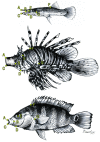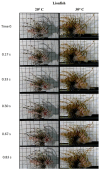Thermal Resilience of Feeding Kinematics May Contribute to the Spread of Invasive Fishes in Light of Climate Change
- PMID: 27897997
- PMCID: PMC5192426
- DOI: 10.3390/biology5040046
Thermal Resilience of Feeding Kinematics May Contribute to the Spread of Invasive Fishes in Light of Climate Change
Abstract
As a consequence of global warming, tropical invasive species are expected to expand their range pole-ward, extending their negative impacts to previously undisturbed, high-latitude ecosystems. Investigating the physiological responses of invasive species to environmental temperature is important because the coupled effects of climate change and species invasion on ecosystems could be more alarming than the effects of each phenomenon independently. Especially in poikilotherms, the rate of motion in muscle-driven biomechanical systems is expected to double for every 10 °C increase in temperature. In this study, we address the question, "How does temperature affect the speed of jaw-movement during prey-capture in invasive fishes?" Kinematic analysis of invasive-fish prey-capture behavior revealed that (1) movement velocities of key components of the feeding mechanism did not double as water temperature increased from 20 °C to 30 °C; and (2) thermal sensitivity (Q10 values) for gape, hyoid, lower-jaw rotation, and cranial rotation velocities at 20 °C and 30 °C ranged from 0.56 to 1.44 in all three species. With the exception of lower-jaw rotation, Q10 values were significantly less than the expected Q10 = 2.0, indicating that feeding kinematics remains consistent despite the change in environmental temperature. It is conceivable that the ability to maintain peak performance at different temperatures helps facilitate the spread of invasive fishes globally.
Keywords: global warming; organismal performance; prey-capture; suction feeding; thermal tolerance.
Conflict of interest statement
The authors declare no conflict of interest.
Figures





Similar articles
-
Biting releases constraints on moray eel feeding kinematics.J Exp Biol. 2007 Feb;210(Pt 3):495-504. doi: 10.1242/jeb.02663. J Exp Biol. 2007. PMID: 17234619
-
Do flatfish feed like other fishes? A comparative study of percomorph prey-capture kinematics.J Exp Biol. 1997;200(Pt 22):2841-59. doi: 10.1242/jeb.200.22.2841. J Exp Biol. 1997. PMID: 9344970
-
Functional morphology of prey capture in the sturgeon, Scaphirhynchus albus.J Morphol. 2003 Jun;256(3):270-84. doi: 10.1002/jmor.10095. J Morphol. 2003. PMID: 12655610
-
Impact of global warming and rising CO2 levels on coral reef fishes: what hope for the future?J Exp Biol. 2012 Nov 15;215(Pt 22):3865-73. doi: 10.1242/jeb.074765. J Exp Biol. 2012. PMID: 23100485 Review.
-
Climate change effects on fishes and fisheries: towards a cause-and-effect understanding.J Fish Biol. 2010 Nov;77(8):1745-79. doi: 10.1111/j.1095-8649.2010.02783.x. Epub 2010 Sep 23. J Fish Biol. 2010. PMID: 21078088 Review.
Cited by
-
Stress response gene family expansions correlate with invasive potential in teleost fish.J Exp Biol. 2022 Mar 8;225(Suppl_1):jeb243263. doi: 10.1242/jeb.243263. Epub 2022 Mar 8. J Exp Biol. 2022. PMID: 35258619 Free PMC article.
-
Combined Effects of Acute Temperature Change and Elevated pCO2 on the Metabolic Rates and Hypoxia Tolerances of Clearnose Skate (Rostaraja eglanteria), Summer Flounder (Paralichthys dentatus), and Thorny Skate (Amblyraja radiata).Biology (Basel). 2019 Jul 26;8(3):56. doi: 10.3390/biology8030056. Biology (Basel). 2019. PMID: 31357558 Free PMC article.
References
-
- Portner H.O., Farrell A.P. Physiology and climate change. Nature. 2008;322:690–692. - PubMed
-
- Portner H.O. Integrating climate-related stressor effects on marine organisms: Unifying principles linking molecule to ecosystem-level changes. Mar. Ecol. Prog. Ser. 2012;470:273–290. doi: 10.3354/meps10123. - DOI
-
- Huey R.B., Kingsolver J.G. Evolution of resistance to high temperature in ectotherms. Am. Nat. 1993;142:S21–S46. doi: 10.1086/285521. - DOI
LinkOut - more resources
Full Text Sources
Other Literature Sources
Research Materials

